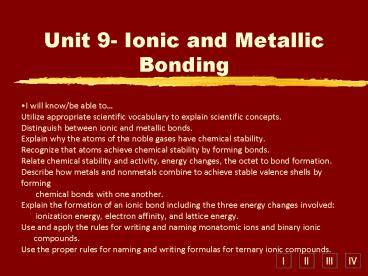I will know/be able to - PowerPoint PPT Presentation
1 / 20
Title:
I will know/be able to
Description:
Unit 9- Ionic and Metallic Bonding I will know/be able to Utilize appropriate scientific vocabulary to explain scientific concepts. Distinguish between ionic and ... – PowerPoint PPT presentation
Number of Views:46
Avg rating:3.0/5.0
Title: I will know/be able to
1
I will know/be able toUtilize appropriate
scientific vocabulary to explain scientific
concepts. Distinguish between ionic and
metallic bonds.Explain why the atoms of the
noble gases have chemical stability.Recognize
that atoms achieve chemical stability by forming
bonds.Relate chemical stability and activity,
energy changes, the octet to bond
formation.Describe how metals and nonmetals
combine to achieve stable valence shells by
forming chemical bonds with one
another.Explain the formation of an ionic bond
including the three energy changes involved
ionization energy, electron affinity, and
lattice energy.Use and apply the rules for
writing and naming monatomic ions and binary
ionic compounds.Use the proper rules for
naming and writing formulas for ternary ionic
compounds.
- Unit 9- Ionic and Metallic Bonding
2
Vocabulary
- Chemical Bond
- attractive force between atoms or ions that binds
them together as a unit - bonds form in order to
- fulfill octet rule atoms tend to gain, lose or
share e- to acquire 8 valence e- - increase stability
3
Vocabulary
- Cation
- Positively charged ion formed when an atom loses
one or more valence e- - Number of protons stays the same, but less
electrons gives positive charge
Loses an e-
4
Vocabulary
- Cations
- Metals lose valence e- easily
- Transition metals have 2 valence e-, usually
lose those two to form 2 ions, but can also lose
d electrons to form other ions
5
Vocabulary
- Anions
- Nonmetals easily gain e- to form negative ions to
get to 8 valence e- - Name is changed to root -ide
Gains an e-
Chloride ion
6
Vocabulary
- Anions
- Nonmetals usually gain e-
- Some can gain or lose, but will gain most often
7
Vocabulary
ION
2 or more atoms
1 atom
Polyatomic Ion
Monatomic Ion
NO3-
Na
8
Ionic Compounds
IONIC COMPOUND
more than 2 elements
2 elements
Tertiary Ionic Compound
Binary Ionic Compound
NaNO3
NaCl
9
Ionic Bonds
RETURN
10
Ionic Bonds
- When oppositely charged ions attract,
electrostatic force that holds them together
ionic bond - Compounds containing ionic bonds ionic
compounds - Electrons are transferred from cations to anions
- Bonds formed between metals and nonmetals (or
contain a polyatomic ion)
11
Ionic Bonds
- Na
1s2 2s2 2p6 3s1 1s2 2s2 2p6 3s2 3p5
RESULTS IN
Na
1s2 2s2 2p6 1s2 2s2 2p6 3s2 3p6
12
Properties of Ionic Compounds
- Most ionic compounds are crystalline solids at
room temperature - Arranged in repeating compounds generally have
high melting points - Large three-dimensional patterns
- Ionic e- attractive forces result in very stable
structures
13
Properties of Ionic Compounds
- Physical structure
- Ions are packed into regular repeating pattern of
ions crystalline structure
Ionic Bonding - Crystal Lattice
14
Properties of Ionic Compounds
- Ionic compounds can conduct an electric current
when melted or dissolved in water - When ionic compounds are dissolved in water the
crystalline structure breaks down so ions are
able to move freely which results in conductivity
15
Summary
IONIC
Form crystalline structures
Bond Formation
Arranged in repeating three dimensional patterns.
Type of Structure
Physical State
Solid _at_ room temperature
Melting Point
Have high melting points
Solubility in Water
Soluble in water
Can conduct an electric current in liquid when
dissolved.
Electrical Conductivity
Other Properties
Hardness- Hard or Soft, Brittleness-Flexible-Britt
le
16
Metals
- Metals are good conductors because the valence
electrons are able to flow freely - Valence electrons of metals can be thought of as
a sea of electrons
17
C. Metallic Bond
Metallic Bonding - Electron Sea
18
D. Metallic Properties
- Have luster, are ductile and malleable
- Luster shine
- Ductile ability to be drawn into wires
- Malleable ability to be shaped, pounded, etc
19
D. Metallic Properties
- Properties can be explained by the mobility of
electrons in metals - When subjected to pressure , the cations easily
slide past each other like a ball bearing
immersed in oil.
20
B. Types of Bonds
METALLIC
e- are delocalized among metal atoms
Bond Formation
Smallest Unit
electron sea
Physical State _at_ RT
solid
Melting Point
very high
Solubility in Water
no
yes (any form)
Electrical Conductivity
malleable, ductile, lustrous
Other Properties





![❤[READ]❤ 50 Things to Know about Screenwriting : Expert Insights & Essential Techniques PowerPoint PPT Presentation](https://s3.amazonaws.com/images.powershow.com/10079483.th0.jpg?_=20240716116)

























